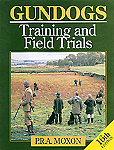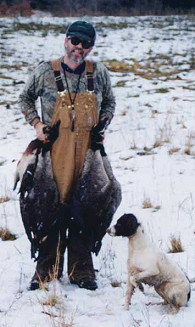|
Gundogs; Training and Field Trials by P.R.A. Moxon, 16th Editon
First published in 1952, this sixteenth edition was
published in 1996 and is in its fifth printing.
Obviously the demand for this classic has not
slackened. Moxon is to be commended for the longevity
of this book - equaled by few.
Moxon's appeal, in part, has to do with his underlying
theme of humane treatment of the dogs. Of course, a
book advocating cruel treatment would never have such
longevity. And so, Moxon takes great pains to dispel
the need for 'breaking' a dog. Granted, back in
1952, he was undoubtedly marching to a different
drummer.
This book also combines practical care and feeding
advice, and as such has required constant revision, as
the state of veterinary science has advanced. This is
part of the appeal of such a book: a comprehensive
manual for the novice, but it brings with it the
requirement of constant revision. With Moxon's
passing, I wonder if this task will be attempted by an
editor?
Interestingly, one section talks of a raw meat diet
(paunches) whereas another has been updated and speaks
well of kibble.
Generalities
Most training books lean one way or the other - too
general or too specific. This book is hard to
categorize. On one hand, because the book addresses
both flushing and pointing breeds - as well as
retrievers, it is rather general. On the other hand,
Moxon's observations of the field trial scene is
specific and quite interesting. All in all, the tone
of the book leads one to think that spaniels held a
special place in his heart. To quote Moxon, "Of all
branches of gundog work I think I like spaniel
training best."
"It was just one of those things that illustrates the truth that trails are largely a matter of luck."
Make no mistake about it, the book is about the UK
shooting scene. If you are curious about "picking up
at shoots", ferreting, and rabbit pens, this is a good
resource. The appendix to the book even includes the
1995 Kennel Club Field Trial Regulations and
Guide to Conduct of Field Trials, as well as a
listing of (UK) Field Trial Societies.
Target Audience
This book has long been considered a good introduction
to the sport in the UK, perhaps held in the same
esteem as Jim Spencer's HUP! in the United
States. Hence, its longevity. Because it covers
pointers and retrievers as well as spaniels, it
perhaps is aimed at those who have not even decided
which breed suits them best.
As a caution to the novice, at least here in the
States, the whistle sequences in the book are not the
same as employed by most American trialers. If you are
even considering trialing in the states, you should
use the locally standard commands so that your dog
could easily adapt to a pro trainer should that be
required and so that the judges don't think your dog
is mishandling commands.
Training Methods
Moxon's spaniel training methods are fairly typical
and time-tested. They do not seem to clash with a lot
of methods in the manner that Joe Irving's or Bill
Tarrant's seem to do. Be aware that the book does not
present a good sequential methodology in the manner of
Spencer, or more recently, Roettger and Schleider's books do.
"Some men contend that it is the dogs which should be
judged, not the handlers, but I do not see how one can
really separate the two. The aim of a Trial is to find
the best dogs and the best handlers, and though
the dog is the main consideration handling cannot be
entirely ignored."
Trials and Training
Where this book really shines is when Moxon makes
personal observations about the nature of field
trails. Although there are many differences between
field trails in the UK and the US, the basic nature of
these competitive events remains the same everywhere.
And Moxon seems to bring a good attitude, brought on
no doubt by his many years of experience in the game.
He offers good advice on nerves, judging, and some of
the tricks that handlers try to play on judges. His
chapter on the Business of a training kennel is also
very insightful, offering advice to those considering
the services of a pro.
I find it very interesting that some of the trial
issues discussed by Moxon, such as handling on
runners, or moving up with the judge on a retrieve,
are issues that I've discussed in the last few weeks
with others. It is the timelessness of Moxon's advice
which had kept the book going for sixteen editions.
|
|
|
| Bookstore | The Bookshelf | Advertise on SJ | Classifieds | Resources | NEW! Events | Letters | Archives | Spaniel Journal | |


